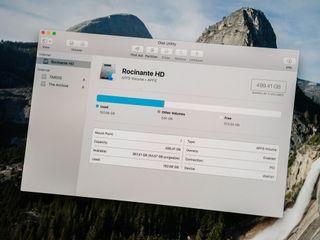Apple Geniuses having trouble diagnosing problems with your Mac? APFS might be the reason

If you've ever taken a Mac in for repair at your local Apple Store Genius bar, you'll know that the problems that arise on your Mac can have solutions that range from the simple to the "wipe the hard drive and start over" complicated. But with the release of macOS 10.13 High Sierra, a new wrinkle has been added: APFS, the Apple File System. APFS replaces HFS+, the files system used by Apple products for decades.
As Charles Arthur, formerly of The Guardian, found out, Apple's Genius Bars might not be fully ready to deal with drive problems on an APFS system. These employees often utilize network drives to diagnose problems on your Mac, booting from these drives instead of your Mac's HDD or SSD to circumvent any problems that the internal drives might cause. However, in attempting to get a fix for what he suspected to be a graphics card issue, Arthur found the Geniuses working on his computer confounded by their inability to run video card drivers on his hard drive. After wiping his Mac's internal drive, Arthur realized the problem:
At this point I suddenly realised why the network-booted versions hadn't been able to run the video card drivers from my hard drive, and now they could. The network drives were formatted with HFS+, which is the file system Apple Has been using on Mac OSX (and MacOS) for a couple of decades. That's why the version number on the network drive was 10.12 - the file format for Sierra.But I had brought the machine in running 10.13 - High Sierra - which uses the APFS filesystem. APFS brings a number of benefits, such as "instant" file copying, disk space saving, better encryption performance, inherent SSD trim, and faster boot times, but it isn't back-compatible with HFS+; if you boot from an HFS+ drive, it won't be able to read a file encoded in APFS. (APFS can work read HFS+, of course.)
So it turns out that the drive wipe had been for nothing. Arthur did have a backup of his Mac, however, from which he eventually restored his machine (one moral of this story: for God's sake, have a backup). He was also able to get a new logic board and some general cleanup for his Mac, and the Geniuses did indeed fix his faulty discrete graphics card, which was, as he suspected, the source of the issue.
So the big lesson to be learned from this is: if you need your Mac serviced, make sure to let the Genius Bar at your Apple Store know if your system is running on APFS. If you don't know whether your Mac's drive is formatted in APFS, open Disk Utility on your Mac and select your Mac's primary drive. It will appear right under the name in the main window.
Master your iPhone in minutes
iMore offers spot-on advice and guidance from our team of experts, with decades of Apple device experience to lean on. Learn more with iMore!
Joseph Keller is the former Editor in Chief of iMore. An Apple user for almost 20 years, he spends his time learning the ins and outs of iOS and macOS, always finding ways of getting the most out of his iPhone, iPad, Apple Watch, and Mac.

All-screen iPhone SE 4 tipped for a 2025 launch, but those hoping for a low-budget powerhouse are set to be disappointed

Apple's iPhone 16 could finally get the capacitive buttons that the iPhone 15 missed out on with a supplier now lined up

An Apple Vision Pro headset helped this Brazilian surgeon repair an injured shoulder like never before
Most Popular



